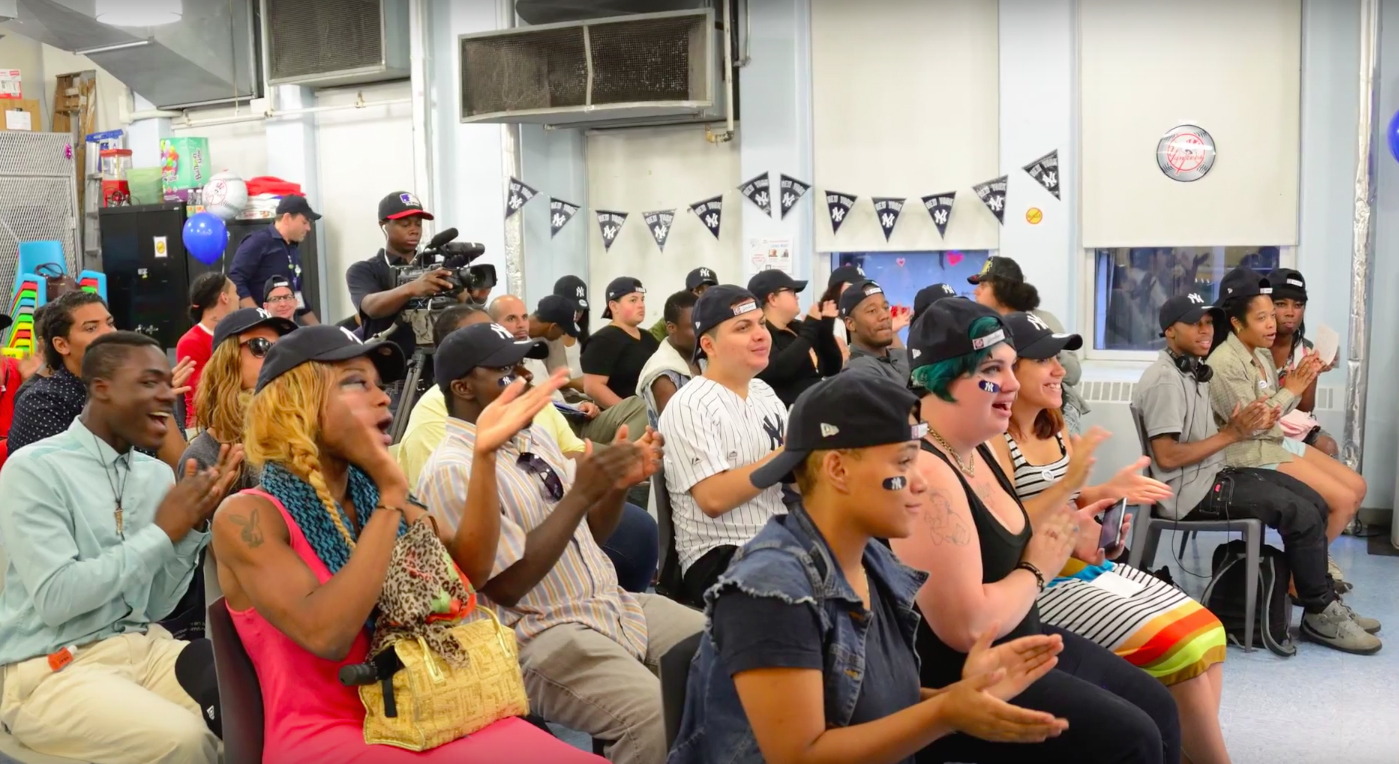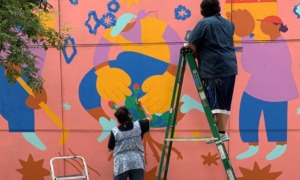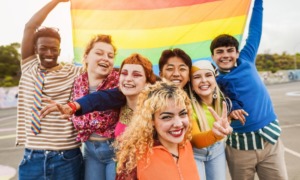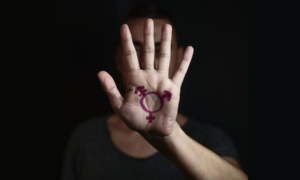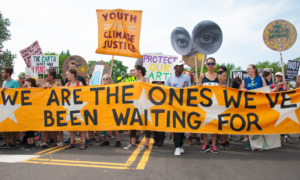Since the presidential election, 18-year-old Casey Akers says she has been “really scared for the future.” She watched with alarm as then-candidate Donald Trump singled out vulnerable minority groups for hostile remarks. Akers fears that LGBT youth like her will become another target of the White House. At the same time they face discrimination and anti-gay bias by their peers, according to reports released in December.
A senior at Timber Creek High School in suburban Fort Worth, Texas, Akers said she has lived with harassment and bullying at school ever since she came out as a lesbian in eighth grade. “Hateful words” from some classmates were routine. “In the hallways they would definitely throw ‘faggot’ around, and online they would call me a dyke,” she said.
Akers also faced institutional bias because of her sexual orientation. Texas and seven other states — Alabama, Arizona, Louisiana, Mississippi, Oklahoma, South Carolina and Utah — have laws censoring discussion of same-sex relationships or transgender identity at school, a ban that only added to Akers’ sense of isolation. “As a lesbian 16-year-old, it’s hard to find acceptance in a classroom where you can’t even talk about how you feel,” she said.
LGBT advocates note it’s also hard to get appropriate health information if teachers can’t talk about gay sexuality or learn about the history and contributions of gay people if they are excluded from the curriculum. (See related story, HEALTH, page 12.) After-school functions and extracurricular activities can themselves become a hostile environment, or they can act as a supportive resource that makes life easier for LGBT students.
Without intending to, Akers caused an uproar in her conservative school district when, as a sophomore, she planned a small lunchtime ceremony to invite another girl to prom. A school administrator barred the “promposal,” saying it would be disruptive, but Akers believed the real problem was her sexual orientation. The incident quickly went viral and attracted statewide and then national attention. “It spiraled into a big deal,” said Akers.
Akers tried to work with school district administrators to add sexual orientation and gender identity to their anti-discrimination code of conduct “so students like me would be protected,” she said. Her local community became fiercely divided over the new language, she said, with several school trustees and many parents and residents opposed to creating specific protections for LGBT students.
When a school board meeting to vote on the proposed changes attracted a standing-room-only crowd, Keller Independent School District Superintendent Randy Reid postponed the vote indefinitely. In an email at the time, Reid said, “the issue has become extremely polarizing, with the great potential of creating feelings of winners and losers.” Reid’s office did not respond to requests for an update on the policy.
Akers was not able to spur changes to her school’s code of conduct, but her activism did produce results: For the first time, last year Timber Creek High School formed a gay-straight alliance, a supportive student club in which she’s now active.
Ongoing hostility toward gay, transgender students
Last year the New York-based advocacy group Human Rights Watch visited Timber Creek High School and schools in four other states that have no specific anti-discrimination protections for LGBT youth. HRW researchers interviewed more than 350 students and more than 100 parents, teachers, administrators and service providers, to compile a report, released last December, which found that school — and affiliated after-school programs such as sports and clubs — remain a hostile environment for many LGBT youth.
“A lack of policies and practices that affirm and support LGBT youth — and a failure to implement protections that do exist — means that LGBT students nationwide continue to face bullying, exclusion, and discrimination in school, putting them at physical and psychological risk and limiting their education,” concluded HRW.
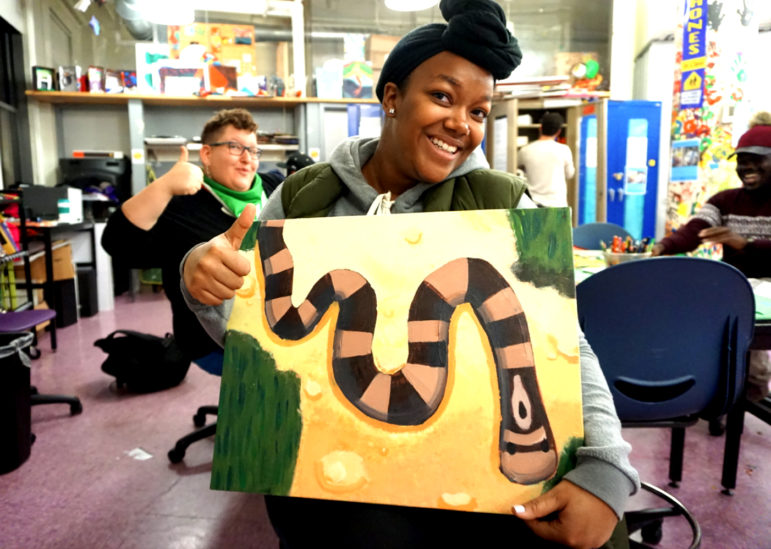
Photo courtesy of HMI
Youth member Kadesha shows off her artwork during open art programming at Hetrick-Martin Institute, as Art Therapy Counselor Glenn Smulyan gives a thumbs-up.
Lead author Ryan Thoreson, a fellow in HRW’s LGBT Rights Program, said gay people have made some advances nationally, but there remain serious challenges for gay and transgender students. “The perception often is that as attitudes change and laws improve, that must mean that problems have been fixed for LGBT kids in schools, but what we found is that’s definitely not the case.”
The HRW findings were confirmed by a second report — a biennial national school climate survey — also released in December by GLSEN, the Gay Lesbian and Straight Education Network. It, too, found an overwhelming majority of gay and transgender students experience bias at school.
“We know that LGBT youth are still disproportionately discriminated against, that they face harassment and bullying, and we’ve been able to document that LGBT youth also face higher rates of discipline,” said Nathan Smith, GLSEN director of public policy.
The GLSEN survey sample included 10,528 high school students from all 50 states and the District of Columbia. The data shows 85 percent of students experienced verbal harassment and 66 percent experienced LGBT-related discrimination at school. According to the survey, 32 percent of gay students missed at least one day of school in the previous month due to feeling unsafe or uncomfortable; 39 percent avoided bathrooms and 38 percent avoided locker rooms; 72 percent avoided school functions and 66 percent avoided extracurricular activities because they felt unsafe or uncomfortable.
Administrators often failed to respond to anti-gay incidents, according to the GLSEN researchers. Nearly two-thirds of students who reported being harassed or assaulted said that school staff did nothing in response or told the student to ignore it. The GLSEN survey found that students exposed to LGBT bias were likely to have lower grade point averages and higher incidences of depression.
Finally, both the GLSEN and HRW reports cited a disturbing new trend: an increase in cyberbullying, which often pursued students into their homes.
Some good news for LGBT youth
Despite the ongoing challenges LGBT students face, both HRW and GLSEN also documented some positive developments. According to HRW’s Thoreson, long-term advocacy efforts have paid off. “We’ve seen some improvements over the last few years, and they have not been an accident,” he said. “They’re the result of conscious work by school administrations, state departments of education, and the federal government.”
“The climate for LGBT students is getting better, although at a very slow rate,” agreed GLSEN’s Smith. The GLSEN school climate survey showed “significant signs of improvement” since 2001. Reports of physical bullying (being pushed or shoved) and assault (being punched, kicked or injured with a weapon) had declined. Researchers also found that supportive structures such as gay-straight alliances had reached their highest level since the survey began. A little more than half (54 percent) of students said their school had a GSA or similar club.
Significantly, 20 states have adopted measures that specifically prohibit discrimination or bullying on the basis of sexual orientation or gender identity: Arkansas, California, Colorado, Connecticut, Illinois, Iowa, Maine, Maryland, Massachusetts, Minnesota, Nevada, New Hampshire, New Jersey, New York, North Carolina, Oregon, Rhode Island, Vermont, Washington and the District of Columbia.
LGBT advocates say such enumerated anti-discrimination laws are important because they work: GLSEN found that students in schools with comprehensive policies were less likely to experience victimization and less likely to hear homophobic remarks frequently. They were more likely to report incidents to school staff and more likely to report that school staff intervened when hearing anti-LGBT remarks.
Thoreson said enumerating protections strengthens anti-discrimination measures, and that’s why HRW’s top recommendation to state legislatures and school administrators is to enact laws or policies specifically protecting students on the basis of sexual orientation and gender identity. “Students know what behavior is prohibited, and teachers and administrators know what conduct they should be watching out for and know that they have the green light to intervene when they see inappropriate behavior,” he said.
[Related: New Report Shows LGBT Students Face Ongoing Discrimination]
In Nevada, for example, the law requires the school principal or a designee investigate reports of anti-gay or transgender targeting the same day or “as soon as possible to get the student protected,” said Victoria Blakeney, with the Office for Safe and Respectful Learning Environments at the Nevada Department of Education. The school has two days “to complete an investigation and enact a safety plan for the student.”
The school must check back with the student to ensure that the safety plan is working and initiate “restorative work” with the offender, said Blakeney, who noted that teachers are also required by law to reports instances of bullying. The law applies to all sports, clubs and OST programs that meet at or are provided by the school.
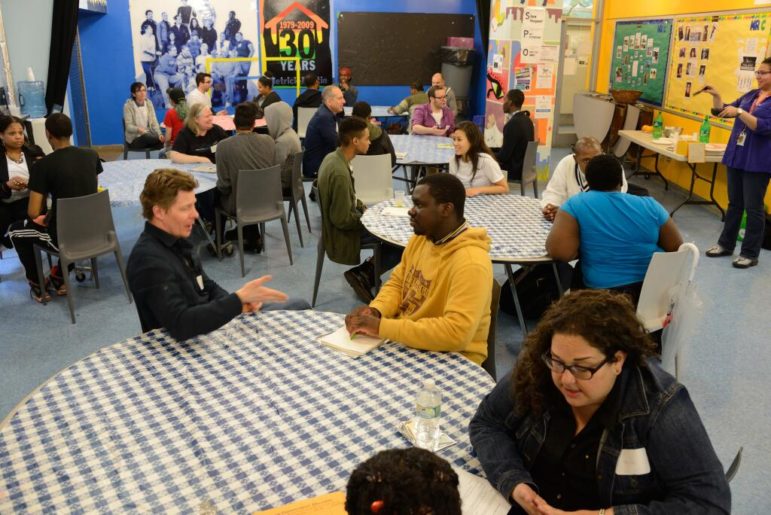
Photo courtesy of HMI
Youth members at Hetrick-Martin Institute get career advice from AOL employees during a speed-mentoring event, part of HMI’s job readiness training program.
Trump White House signals reversals
Now there are signs that the climate for LGBT rights could be shifting again. Within days of being confirmed, new Attorney General Jeff Sessions began setting a new tone by backing off protections for transgender students.
In what had been another sign of progress for LGBT youth, the Education and Justice departments during the Obama administration enacted guidance — an agency statement that sets forth policy or interprets a statute — protecting transgender youth under Title IX, a federal law that prohibits discrimination on the basis of sex in schools that accept federal funding. Under the guidance, transgender students would have to be allowed to use school bathrooms that match their gender identity.
A dozen states, led by Texas, quickly challenged the transgender-friendly interpretation, and last August a federal court issued a nationwide injunction blocking the Title IX guidance from taking effect. The Justice Department appealed the injunction, but days before a federal judge was scheduled to hear arguments on the issue, new Trump Justice Department lawyers reversed course, withdrawing objections to the injunction. The upshot? States can continue to require transgender students to use school bathrooms that correspond with their gender assigned at birth while the case makes its way through the courts.
Civil rights and LGBT advocates were disappointed by the change. “Transgender students are entitled to the full protection of the United States Constitution and our federal nondiscrimination laws,” Chad Griffin, president of the Human Rights Campaign, said in a statement. “It is heartbreaking and wrong that the agency tasked with enforcing civil rights laws would instead work to subvert them for political interests. President Trump must immediately reverse course and direct the DOJ to uphold guidance protecting transgender students.”
Separately, 10 additional states, led by Nebraska, filed a second lawsuit challenging the Obama-era policies on transgender students’ access to bathrooms.
The issue will soon come to a head. On March 28 the U.S. Supreme Court will hear oral arguments in a case brought by a Virginia high school student who was denied access to the boys’ bathrooms and locker rooms at his school. At press time, it was not clear whether President Trump’s high court nominee, Colorado judge Neil Gorsuch, would be confirmed by then.
What comes next?
LGBT advocates now worry Trump appointees and Vice President Mike Pence — an evangelical Christian who fought the expansion of LGBT rights as governor of Indiana — will oversee the rollback of other LGBT protections. They battled the Sessions nomination to head the Justice Department. “He’s been hostile and at best indifferent to protecting the rights of LGBT people and women,” said Rick Zbur, executive director of Equality California, a statewide LGBT civil rights organization. The organization took the unusual step of formally opposing Sessions’ confirmation.
Then-Sen. Sessions was a co-sponsor of the First Amendment Defense Act, which would allow landlords, businesses or government agencies to discriminate by refusing to provide services to LGBT people in accordance with their religious beliefs.
Education and LGBT advocates also fought the nomination of Betsy DeVos, a billionaire philanthropist and Republican donor, to head the Education Department. Opponents flooded lawmakers’ offices with phone calls and emails calling for her to be voted down. She was confirmed after Vice President Pence cast a tie-breaking vote in the U.S. Senate in early February.
Without a public record, civil rights advocates are unsure where DeVos stands on a number of issues that will affect LGBT youth. “Is she a proponent of safe and supportive schools initiatives? Is she in favor of the [transgender] guidance from the Obama administration?” asked Thoreson. “We don’t know.”
‘We need to be even more vigilant’
Looking to the future, high school senior Casey Akers fears LGBT rights will suffer under the Trump administration. She worries not so much for herself, because she says she’s “pretty strong” and has a supportive family and friends, but for other LGBT youth who may not be so lucky. “It scares me that kids won’t be able to truly out themselves because of fear of the man who sits in the White House and the people he surrounds himself with,” she said.
Some youth-service providers are already seeing fallout from the election in their daily work. “LGBT young people live under higher levels of stress, of anxiety, and we’re seeing all of that exacerbated now, post-election,” said Thomas Krever, CEO of the Hetrick-Martin Institute, a large LGBT youth-service organization in New York.
HMI provides what Krever said is the largest hot-meal program in the nation for LGBT youth, serving more than 12,000 meals last year and more than 2,200 youth in free after-school and weekend programs, providing mental and emotional health counseling and case management; HIV, pregnancy and sexually transmitted disease prevention programs; as well as arts and academic enrichment and job readiness programs.
HMI shares its New York City location with Harvey Milk High School, a public high school for LGBT youth that is named after the first openly gay man elected to public office in the U.S. HMI operated the school until 2002 when it became fully accredited; the school is now administered by the NYC Department of Education. HMI also provides youth services in Newark, New Jersey. The institute is funded through city, state and federal partnerships, as well as corporate and foundation grants.
Krever fears the hostile tone and targeting of some minority groups in the months prior to the election have already affected the mental health of young people in his community. All of HMI’s providers are trained in mental health first aid, and the response, he said, must be heightened vigilance. “As service providers, how we cope is recognizing the signs of trauma, of anxiety, and working to build the resiliency and strength of our young people so they can be advocates for themselves and others,” said Krever.
Suicide prevention classes aimed at LGBT youth in California
A new California law requires that all middle and high schools in the state provide suicide prevention education specifically recognizing the higher suicide risk of LGBT youth. Suicide is the second-leading cause of death for youth 10 to 24 years old, according to the U.S. Centers for Disease Control and Prevention. And gay, lesbian and bisexual young people are up to four times more likely to attempt to take their own lives than non-LGBT youth, according to the Trevor Project, a co-author of the bill.
With the passage last August of Assembly Bill 2246, California becomes the first state to require mandatory suicide prevention classes for LGBT students in grades seven through 12, said Rick Zbur, executive director of Equality California, a statewide LGBT advocacy organization that also co-authored the legislation. “What’s unique about the California law is that it recognizes that LGBT students face additional challenges due to discrimination and lack of acceptance, and the new law requires schools to focus on those challenges,” he said.
Under the law, school districts will be required to create a model policy on suicide prevention with the special challenges of LGBT youth in mind before the beginning of school this fall. An approved model policy is already available through the Trevor Project, which could be adopted or adapted by the State Department of Education and local educational agencies.
At a minimum, the policy must address training teachers to recognize the warning signs of suicide, including materials on how to identify appropriate mental health services, and when and how to refer students and their families for services. Since the law is considered a mandate, any costs that local education agencies or schools districts incur to comply with it will be reimbursed by the state.
The California law mandates suicide prevention programs also focus on other youth more likely to attempt suicide, including: youth bereaved by someone else’s suicide; youth with disabilities, mental illness or substance use disorders; and youth experiencing homelessness or in out-of-home settings, such as foster care.
[Related: Not Enough Letters? About this print edition]
More related articles:
Here’s a Collaborative Way to End Homelessness Among LGBT Youth
A Call for Action in OST as Gay Teens Face Violence, Many Other Risks
Discrimination Lands Many LGBT Youth in the Justice System, New Report Says
CDC Finds LGB Students at Greater Risk of Bullying, Sexual Violence


